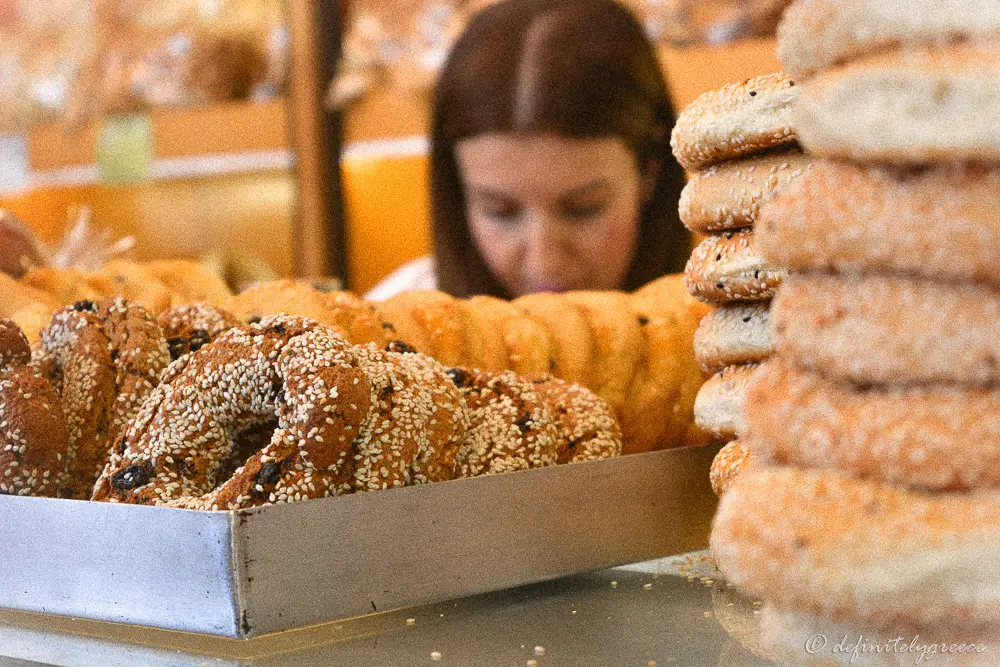
The Greek Breakfast And Then Some
The Greek Breakfast And Then Some

☞ Table of Contents:
The value of having a hearty breakfast is undisputed, as is the importance of the Mediterranean diet. Even UNESCO has cited it for its cultural significance. The Greek breakfast is the ideal combination of these two and the perfect fuel to keep you energized during your explorations in this beautiful land!
The basic ingredients for a Greek breakfast are bread, jams and marmalade, fresh fruit and vegetables, olive oil, yoghurt, honey and sweets, cheese and pita. However, each region of Greece is famous for its own traditional products and recipes.
The crown of the Greek breakfast is bread. Bread has been an integral part of rituals and meals since ancient times when it was offered in sacrifices, and its role in religious life was retained in the new religion, Christianity.
In older times each housewife would bake her family’s bread two or three times a week occasionally adding spices such as oregano, olives or raisins to enhance the taste. Today, bakeries throughout Greece bake premium bread daily using wheat, barley or emmer flour, each following traditional recipes whose origins are lost in time.
In Northern Greece and especially in the regional capital of Thessaloniki, the most popular type of bread is the koulouri, a kind of round bread ring baked with sesame seeds and a pinch of salt.
History and Variations
Rusks made from barley or wheat are as popular in the south as koulouri is in the north. In Crete and Karpathos, they are baked with a pinch of cumin to accentuate their rustic taste; on the island of Lesvos they prefer anise and in some islands of the Cyclades, crocus.
Occasionally rusks are baked in smaller sizes with honey or sugar to eat as a sweet with your Greek coffee or freshly squeezed orange juice.
There are so many ways to enjoy freshly baked bread! In the Greek culinary tradition, bread accompanies virtually any dish, cheese or marmalade.
The art of turning top quality fruit to delicious marmalade or jams has been revived in the past few years. Many small coops and farmers’ associations make their own handmade jars and sell them in local markets using only natural products and no preservatives. Figs, blackberries, strawberries, cherries, peaches and others are among the different flavors that you can find for sale.
You can pour a few teaspoons of your favorite jam in a bowl of chilled Greek yogurt for a sweet and healthy way to kick start your day.
For a modern twist to a traditional breakfast, you can combine sweet jams with salty cheese. Cheese, also, has had a central role in Greek life for thousands of years, with cheese-making and eating being mentioned in texts as old as Homer’s Odyssey.
You are, naturally, familiar with feta cheese which is produced in many places throughout Greece, yet there are also hundreds of other varieties of cheese that are prepared in different locales and whose rich taste is defined by the climate, recipe and technique used.
The graviera and manouri of Crete, kalathaki of Lemnos and the kopanisti of Mykonos are among some of the most well-known varieties of Greek cheese that can be combined with a wide selection of salamis and cured meats, such as apaki from Crete, and sigklino from Mani for delectable offerings.
Many visitors, overwhelmed by the intricacy of gourmet dining and over-complication of recipes wish to go back to authentic tastes that define the Greek culinary map.
The best way to go rustic and enjoy the best Greece has to offer is to spray a slice of freshly baked bread with extra virgin olive oil and eat it with a pinch of salt and oregano.
You will then understand why olive was the sacred tree of ancient Athens and comprehend why athletes competed for nothing more than an olive tree wreath. Hippocrates, the father of medicine, underlined the beneficial qualities this blessed oil has in curing wounds and other illnesses.
Greeks use olive oil almost everywhere: in cooking, in salads, on a barley rusk with feta cheese and oregano or when baking traditional fyllo to make pita.
Greek pita is made by placing two fylla- handmade pastry sheets- one on top of the other with a stuffing and baking them in the oven. The fylla are made using only water, flour and olive oil. Over the ages countless recipes for stuffing the fylla have been created throughout Greece and each area prides itself on producing the tastiest stuffing.
Popular pitas are spinach pita or spanakopita, feta cheese pita or tyropita and sweet pumpkin pita or kolokythopita. Except for variations in stuffing, there are also variations in the pita shape and size, all of which are ideal to eat at the beginning of your day.
Speaking of phyllo, it also features prominently towards the end of many Greek meals as housewives often prepare two kinds of dessert: siropiasta (meaning a category of sweets that are usually made from Rethimno is probably not the first city that comes to mind when you think of Crete, but that unassuming beauty is where its charm lies phyllo and filled with sweet stuffing swimming in delicious syrup) and tou koutaliou or spoon sweets, that are fruit naturally preserved in syrup.
The latter are called spoon sweets because they are traditionally served in a small plate with a tiny spoon. Some of the typical flavors are orange, bergamont, sour cherry, rose and fig. Typically, they are combined with yogurt or ice cream.
Other Additions
A traditional Greek breakfast would be incomplete without a plentiful array of fresh fruit topped with honey and dried nuts.
This favored delicacy was enjoyed by ancient Athenians at the symposia. Another favorite snack mentioned in ancient texts is pasteli, a sweet bar made with sesame seeds, almonds and honey.
Recognizing the nutritional value of the Greek breakfast, many hotels and guesthouses all over Greece now prepare and offer it for guests. Getting to know the cuisine of a people can help you to better understand their history and heritage.
In the case of Greece, partaking in the Greek breakfast will open up new culinary horizons and introduce you to a host of natural yet premium products and eating habits.
*Disclaimer: This page might include affiliate links. If you decide to book something through one of them, I might get a little bonus, but it won't cost you anything extra.*

























